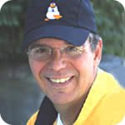While you were out
 Need a reason to listen to your body? Try watching runners undergo surgery.
Need a reason to listen to your body? Try watching runners undergo surgery.
Most of us see only the ceilings of operating rooms. We're wheeled in on a gurney, moved to the operating table, where we take a few whiffs of something, and the next thing we know we're in recovery. I think this is just as well. The business of surgery is an awkward juxtaposition of absolute precision and high school shop class. Men and women with decades of training and experience operate on patients with what seem like medical torture devices. I know this because last January I had a chance to observe arthroscopic surgery. And by observe, I mean I was in the operating room, within feet of the patients, within sight of everything going on.
I went to visit my good friends John and Alice Corbett, who moved from Rockford, Illinois, to Oro Valley, Arizona, to open a running specialty store, All About Running and Walking. In the community that has grown around the store are a couple of die-hard running enthusiasts who also happen to be orthopedic doctors and surgeons. Jon Wang, a 62-year-old Boston-qualified runner, and William (Bill) Prickett agreed to allow John and me to scrub in and be observers for a day.
As with any hospital visit, the first step was signing forms. Essentially, we had to agree to sit still, not to touch anything, not to annoy the doctors and technicians, and - most important - to fall backward into the wall if we passed out, not forward into the surgeon or patient. This "falling backward" procedure was explained to us by no fewer than four people.
Dr. Wang told us that most of the injuries he sees are preventable. Both of the knee surgeries we saw were done on patients who are runners. From what I can tell, the doctors cut four holes into the knee area, shoot water into one, suck water out of the other, stick a camera into the third, and jam probes and saws into the fourth. The process is a messy one. There's stuff going in and junk coming out, the constant whirring of machines, and the intermittent whirring of the saw. I'm sure it's more complicated than this, but from where I was sitting, that's what it looked like.
The body, it seems to me now, is more complicated and yet simpler than I could have imagined. As the surgeons were giving us a lesson in anatomy, I thought of how utterly straightforward the body's systems are. Bones are protected from rubbing up against each other by cartilage, joints enable movement, and the whole apparatus is held together by tendons and ligaments. It couldn't be a more fundamental machine. And yet, many of us seem to believe it's a machine that we can routinely abuse. Even though the body will heal from our indiscretions if we allow it to, many of us insist on pushing beyond the threshold of adaptability.
Having been on the inside, I have to wonder why. Why do we sometimes push too far? Why have I taken anti-inflammatories simply so I could run a particular marathon? Just to prove to myself that I was an athlete? Why would I have ever thought it made sense to run through the pain? I don't know. But I do know it could just as easily have been me on the operating table having my torn meniscus repaired. If you have pain in a joint - and I mean any kind of pain, from a little ache to a stabbing, searing, tear-inducing pain - listen to your body's message. I know I will.
There's so much to be gained by being active, so much to see and feel, that I just can't imagine, now, doing anything that might keep me from these activities for the rest of my life. I now know that - for the most part - I can control whether or not that comes true. And so can you.
Waddle on, friends.

